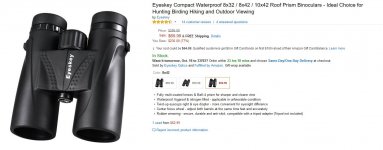morgothaod
Member
I'm new to birding and after reading an Audubon article about binoculars, I decided to buy these Eyeskey 8x42 binocs. I like them so far, but I don't know how they would compare to a more expensive pair. If I decided to spend $500, would the optics be way better? Or is the difference in detail not very noticeable? The same question goes for a $500 pair versus a $1000 pair and a $1000 pair versus a $2000 pair. If any of you have used a cheaper binoc and then tried an expensive binoc, can you tell me what the difference was like? Thank you.





